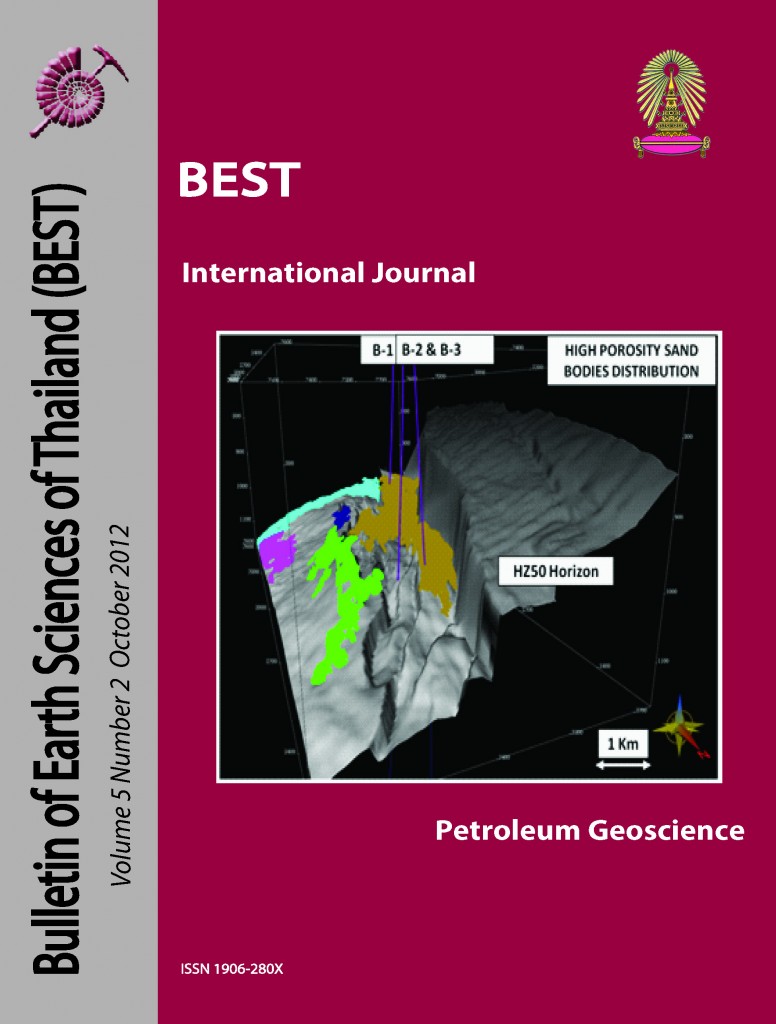DOLOMITIZATION RELATED TO FRACTURE POROSITY EVOLUTION: A CASE STUDY IN PERMIAN RATBURI CARBONATE OUTCROP, YAT PHO SILA THONG DOLOMITE QUARRY – KRABI, SOUTHERN THAILAND
Main Article Content
Abstract
Understanding the nature, style and geometry of dolomitized carbonate reservoirs is of interest in oil and gas exploration and development since the dolomitization process may enhance intra-and inter-particle porosity (sense of Lucia, 2007), so resulting in enriched reservoir properties. Production from Permian Ratburi carbonates is unusual across onshore and offshore Thailand, but does occur in the Nang Nuan oilfield in offshore Southern Thailand and the Sin Phu Horm and Nam Pong gas fields in NE Thailand. Dolomitization in both regions was part of the reservoir diagenetic evolution.
In order to better understand the influence dolomitization has exerted on rock properties in fractured and dolomitized Ratburi Limestone a quarry was studied in detail near Krabi in Southern Peninsular Thailand. Detail fieldwork revealed two dolomite textures, both of which were clearly formed in the burial environment, as responses to an ongoing burial evolution. Diagenetic alteration in the original platform carbonates began with physical compaction, followed by fracturing and faulting that was oriented in N-S direction, clearly revealed that lithology contacts, dolomite distribution and porosity are strongly controlled by structures.
Thus, it seems this type of burial dolomitization in these intensely deformed carbonate terrane has not enhanced poroperm quality. It suggests that either: 1) Dolomitization is not a significant factor in porosity development in the nearby Nang Nuan field; this dolomite in the Nang Nuan carbonate matrix is just a fortuitous association unrelated to porosity enhancement. Or, 2) That there is a different set of fluid processes associated with the dolomite emplacement in Nang Nuan oilfield, which enhanced, not destroyed fracture and matrix porosity. The type of pervasive porosity-occluding dolomitization that occurs in the quarry is called overdolomitization to emphasize that it has destroyed the rock’s reservoir capacity in a rock that is 100% dolomite and 0% porosity. It gives a strong contrast to the open intercrystalline porosity that typifies localized dolomite occurrences in faults, fractures and joints in Miocene carbonates elsewhere in SE Asia.
Article Details

This work is licensed under a Creative Commons Attribution-NonCommercial-NoDerivatives 4.0 International License.
Copyright © 2008 Department of Geology, Faculty of Science, Chulalongkorn University. Parts of an article can be photocopied or reproduced without prior written permission from the author(s), but due acknowledgments should be stated or cited accordingly.
References
Baird, A., and D. Bosence, 1993, The sedimentological and diagenetic evolution of the Ratburi Limestone, Peninsular Thailand: Journal of Southeast Asian Sciences, v. 8, p. 173-180.
Bathurst, R.G.C., 1995, Burial diagenesis of limestones under simple overburden. Stylolites, cementation, and feedback: Bull. Soc. Géol. Fr., 166, p. 181-192.
Brown, C.F., Bunavas, S., Hara, I., javanaphet, J., Jahchandra, N., Johnston,W.D., Sresthaputra,V and G.C. Taylor, 1951, Geological reconnaissance of the mineral deposits of Thailand: U.S. Geol. Surv. Bull. 984 p.
Carnell, A.J.H., and M.E.J. Wilson, 2004, Dolomite in SE Asia – varied origins and implications for hydrocarbon exploration, in : C. J. R. Braithwaite, G. Rizzi, and G.Darke, (eds)., The Geometry and Petrogenesis of Dolomite Hydrocarbon Reservoirs: The Geological Society of London Special Publications, v. 235, p. 255-300.
Chinoroje, O., 1993, Petrographic studies of Permian Carbonates in Southern Thailand, Journal Of Southeast Asian Earth Sciences, v. 8, p. 161-171.
Dunham, R. J., 1962, Classification of carbonate rocks according to depositional texture, Classification of Carbonate Rocks, Memoir of American Association of Petroleum Geologists, v.1, p. 108-121.
Heward, A.P., S. Chuenbunchom, G. Mäkel, D. Marsland, and L. Spring, 2000, Nang Nuan oil, B6/27, Gulf of Thailand: karst reservoirs of meteoric or deep-burial origin?: The Geological Society of London, Petroleum Geoscience, v. 6, p. 15-27.
Kaczmarek, S.E. and D.F. Sibley, 2007, A comparison of nanometer-scale growth and dissolution features on natural and synthetic dolomite crystals: implications for the origin of dolomite. Journal of Sedimentary Research, v. 77, p. 424–432.
Lucia, F.J., 2007. Carbonate reservoir characterization, an integrated approach. 2nd Ed., Springer Verlag . 336 p
Machel, H.G., 2004, Concepts and models of dolomitization: a critical reappraisal: Geological Society, London, Special Publications v. 235, p. 7-63.
Racey, A., 2011, Petroleum Geology. In : Ridd, M.F., Barber, A.J. & Crow, M.J. (eds)., The Geology of Thailand. Geological Society, London, p. 351-392
Sibley, D.F., and Gregg, J.M., 1987, Classification of dolomite rock textures: Journal of Sedimentary Petrology, v. 57, p. 967-975.
Ueno, K., and T. Charoentitirat, 2011, Carboniferous and Permian. In : Ridd, M.F., Barber, A.J.& Crow, M.J. (eds)., The Geology of Thailand. Geological Society, London, p. 72-136


